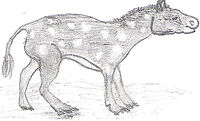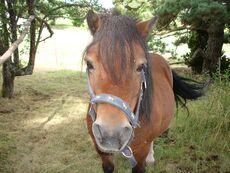Congratulations and thanks to all of the contributors! You can find the recognition on the Main Page. |

A drawing of Eohippus. This is probably what the creature looked like.
Eohippus also known as Dawn Horse or Hyracotherium, is the small animal that the modern horse and intermediate species derived from 60 million years ago in North America. Some stood only 14 inches tall. They had to swiftly run from Diatryma, their predator, and their descendants also evolved as prey to other animals; this is why horses today are very fast runners. Diatryma was a giant prehistoric bird. The first horse was about the size of a hare. It fed on shrubs, and leaves in the woodlands of Europe, East Asia, and North America 50 million years ago.
History[]
Eohippus is the present horse's ancestor. This animal's immediate ancestor was the Condylarth group, from which all hoofed animals derived from.
Characteristics[]
The Dawn Horse was no bigger than a dog or fox, had four toes on whose forelegs, and three behind. Each toe had strong, deep, and horny nails. Like on dogs, Eohippus had a pad behind whose toes.
Whose eyes were set in the middle of the head. This feature prohibited lateral vision, which developed later.
This animal's teeth (all 44) were short-crowned, like pig or monkey teeth. Because of this, the Dawn Horse ate soft leaves on low-growing shrubs.
The coat was similar to that of a deer. It had light spots that acted as good camouflage to avoid predators and stay alive.
Habitat and Food[]
This animal lived in tropical and jungle-like environments. Scientists have actually found monkey remains around Eohippus skeletons. Because of his habitat and his environment, the animal was a browser. They ate soft leaves on low bushes and trees.
Archaeology[]
In 1867 a nearly complete skeleton was found in Eocene rock formations in Wyoming. Therefore, scientists know that equine development started in Wyoming and the adjacent states. In the 1830s, evidence was found in Europe that traces back to the development of equine.
The most complete skeleton ever found was in 1931. It was found in the Big Horn Basin in Wyoming. The skeleton has been mounted by skillful paleontologists at the California Institute of Technology.

|
Eohippus is a stub. |
